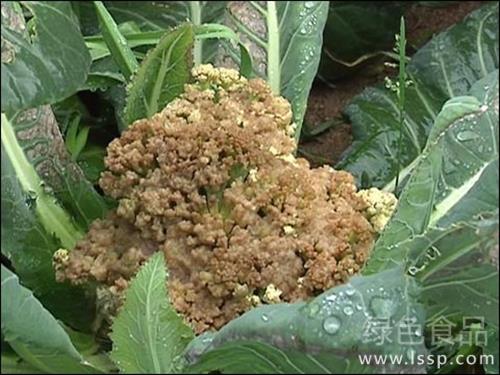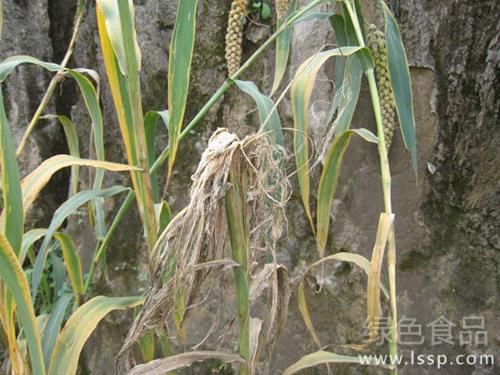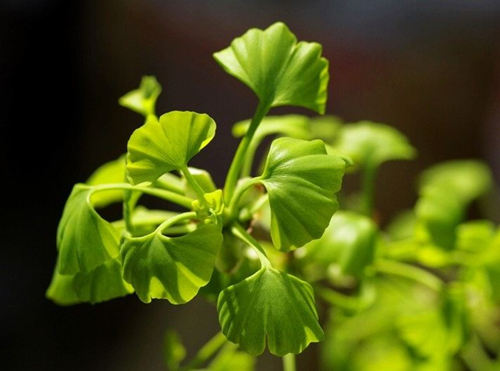Prevention and treatment of soft rot of falling cauliflower with rotten flower ball
The disease of cauliflower in the field showed plant wilting, wax powder falling off, leaf surface mottled and leaf edge wet rot; in the middle stage, the petiole rotted locally, the flower head infected, and spread to the stem and flower branch; in the later stage, the stem and flower bulb began to rot until the cauliflower collapsed, and there was obvious stench in the larger wet rot parts of petiole, flower head and stem. The leaf margin is sick, showing dark brown when dry and yellowish wet rot when the humidity is high. Petiole, stem, flower ball disease, the initial appearance of water-immersed spots, the epidermis is still alive, the tissue is still hard, and then the disease part expands and deepens, begins to rot, and there is slippery fluid outflow.

Soft rot of cauliflower
Control methods: 1. Select heat-resistant and disease-resistant varieties. Green stem varieties, such as Qingnong 65 days, Qingnong 70 days, Qingnong 85 days, Nongmei 70 days, white stem varieties, such as Snow Mountain in Japan.
2. Rotation: rotation with gramineae, legumes and other susceptible crops in seriously diseased areas, advocating flood-drought rotation and avoiding continuous cropping with susceptible crops such as Cruciferae as far as possible.
3. Field management: seed and nursery bed disinfection, cultivation of disease-free and strong seedlings; selection of loose and fertile land, cultivation in deep furrows and high borders; application of calcium, copper, boron and molybdenum fertilizers to correct soil deficiency and avoid root injury and excessive nitrogen application; balanced supply of fertilizer and water to ensure the health of cauliflower; timely prevention and control of insect pests, pre-emptive prevention of black rot and soft rot, removal of initial diseased plants, disinfection of disease holes with lime.
4. Chemical control. Give priority to prevention, spray in time before and after rain, before and after budding, focus on prevention and control, protect petiole, root and stem. The commonly used medicaments are 72% agricultural streptomycin sulfate or 1 million units of neophytomycin soluble powder 3000-4000 times liquid, 95% diclosone wettable powder 600x liquid, copper preparation, etc., which should be used in rotation. If only spray is used for cauliflower soft rot, the effect is not good, especially in continuous cropping and seriously diseased areas, root irrigation must be combined with 0.25-0.5kg solution per plant, about once every 15 days, continuous irrigation for 2-3 times, the control effect is more than 98%, and it can also treat downy mildew, black rot and black spot.
- Prev

Prevention and treatment of mildew on the back of leaves and withered millet at the tip of leaves
Prevention and treatment of mildew on the back of leaves and withered millet at the tip of leaves
- Next

Prevention and control methods of two diseases of ginkgo limited by diseases
Prevention and control methods of two diseases of ginkgo limited by diseases
Related
- Fuxing push coffee new agricultural production and marketing class: lack of small-scale processing plants
- Jujube rice field leisure farm deep ploughing Yilan for five years to create a space for organic food and play
- Nongyu Farm-A trial of organic papaya for brave women with advanced technology
- Four points for attention in the prevention and control of diseases and insect pests of edible fungi
- How to add nutrient solution to Edible Fungi
- Is there any good way to control edible fungus mites?
- Open Inoculation Technology of Edible Fungi
- Is there any clever way to use fertilizer for edible fungus in winter?
- What agents are used to kill the pathogens of edible fungi in the mushroom shed?
- Rapid drying of Edible Fungi

